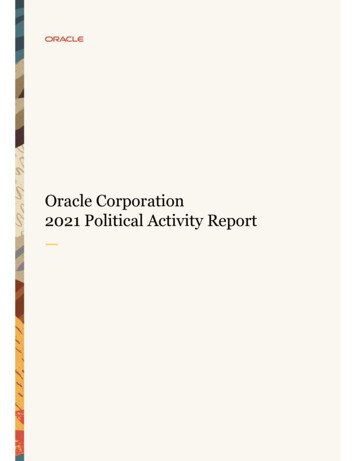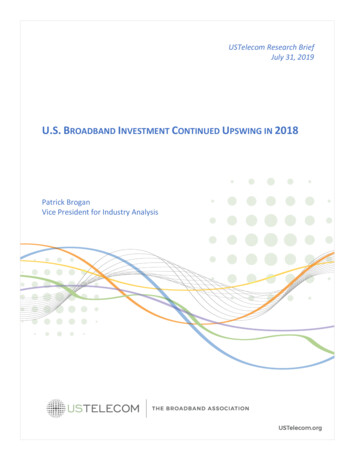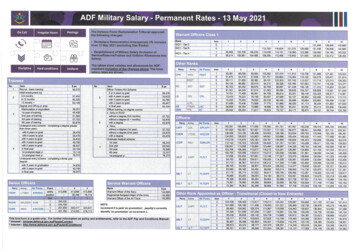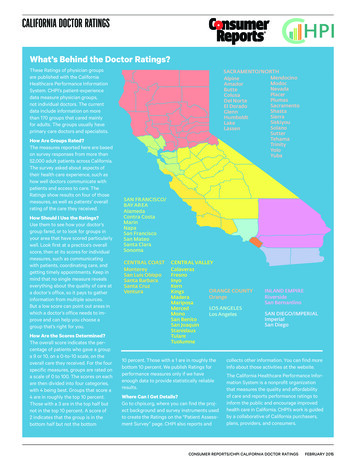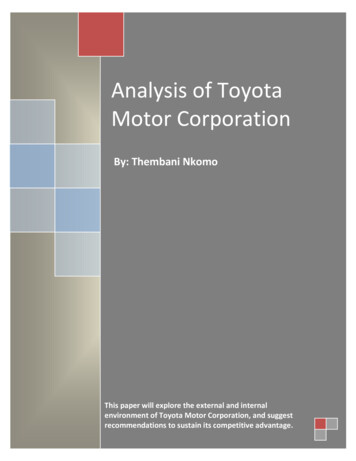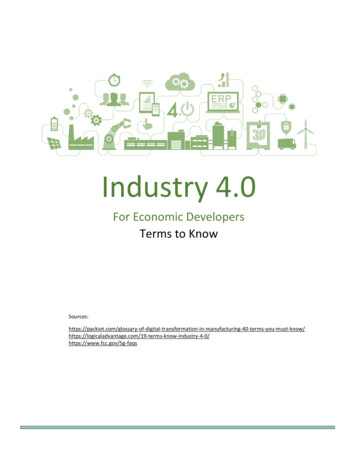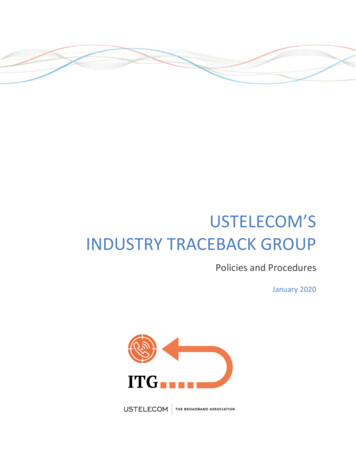
Transcription
USTELECOM’SINDUSTRY TRACEBACK GROUPPolicies and ProceduresJanuary 2020
Table of ContentsIndustry Traceback Group Overview. 2Definitions . 2ITG Membership Categories. 5Traceback Process and Best Practices . 6Privacy of Call Traceback Information . 10Robocall Sourcing Policy . 11Sources to be Utilized for Identifying Calls or Calling Campaigns for Traceback . 11Enforcement Agency ListServ. 12ITG Record Retention Policy . 13Do Not Originate Policy . 13DNO Policies from Government Entities. 14DNO Policies for Private Enterprises . 14Maintaining the Integrity of DNO Implementation . 15Effectiveness Linked to Scale of Implementation . 15APPENDIX A – Enforcement Agency Handoff . 16APPENDIX B – 47 USC 222 . 17APPENDIX C – Sample Email Templates Sent via Portal . 18APPENDIX D – Sample ITG Escalation Letters . 231
Industry Traceback Group OverviewThese Industry Traceback Group (ITG) Policies and Procedures provide information on thecriteria for membership in the ITG and the policies and procedures governing ITG activities.Adherence to the Policies and Procedures will help foster cooperation by a broad range ofsupportive industry participants (including incumbent local exchange carriers, competitive localexchange carriers, wireless carriers, VoIP providers, long distance companies, and wholesaleproviders) to enhance the robust protection of voice networks and users of voice services fromfraudulent, abusive, and/or unlawful robocalls and to reduce the number of illegal robocalls byhelping to identify the source of such calls.The origination, delivery and termination of robocalls involves numerous voice serviceproviders in a complex ecosystem. Over 100 entities have participated in ITG Traceback ofsuspected illegal robocalls to date. As described and defined below, voice service providers fallinto three broad categories: Cooperative Voice Service Providers (those who are fullycooperative with Tracebacks and meet numerous requirements described herein), NonCooperative Voice Service Providers and Call Path Voice Service Providers (those providers inthe call path who don’t meet the many requirements necessary to be labeled CooperativeVoice Service Provider but who participate in Tracebacks and have not been labeled NonCooperative Voice Service Provider).DefinitionsThe following definitions are used throughout the ITG Policies and Procedures: Cooperative Voice Service Provider. A voice service provider committed to protectingnetworks and consumers from fraudulent and abusive robocall traffic. A CooperativeVoice Service Provider must agree to, and abide by, all the policies and procedures setforth in this document. Non-Cooperative Voice Service Provider. A voice service provider that does not followthe best practices contained herein (pages 8-11) and does not cooperate withCooperative Voice Service Provider(s) or USTelecom on Tracebacks of Suspicious Traffic.Specific actions that will result in designation as “non-cooperative” include thefollowing:Non-Responsive When a voice service provider that fails to respond within [BEGIN REDACTED][END REDACTED] business days to [BEGIN REDACTED][END REDACTED]separate consecutive traceback requests from the ITG despite reasonable effortsto ensure appropriate contact information for the provider and reasonableattempts to reach the provider via email and phone.2
Ongoing Illegal Origination An Originator is the last (farthest upstream) voice service provider in aTraceback sequence. The Originator may have placed the call itself, or receivedthe call from its customer.A. Single Campaign When a voice service provider that, [BEGIN REDACTED][ENDREDACTED] or more days after identification by the ITG as an Originatorfor a particular Campaign, originates calls for that same Campaign.B. Multiple Campaigns When a voice service provider that has been identified by the ITG as anOriginator for multiple high-volume Campaigns.United States (U.S.) Point of Entry The U.S. Point of Entry is the first downstream voice service provider routingtraffic that was originated outside the United States on to the United StatesPublic Switched Telephone Network.A. Single Campaign When a voice service provider that, [BEGIN REDACTED][ENDREDACTED] or more days after identification by the ITG as the U.S. Pointof Entry for a particular Campaign, passes calls for that same Campaign.B. Multiple Campaigns When a voice service provider that has been identified by the ITG as theU.S. Point of Entry for multiple high-volume Campaigns.Not Found When a voice service provider whose responses to Traceback requests areentered as “Not Found” for more than [BEGIN REDACTED] [END REDACTED]percent of all responses, absent reasonable explanation.Note: merely responding to Tracebacks, without taking reasonable steps to eliminate theorigination of illegal calls after notification of such calls, is not sufficient to avoid being labeled aNon-Responsive Voice Service Provider.USTelecom reserves the right to publish the identity of and share information about NonCooperative Voice Service Providers. This sharing can be with government enforcementagencies, with other voice service providers, and with the public.A voice service provider’s classification as “non-cooperative” will be removed if the voiceservice provider is no longer engaged in any of the above activities in a [BEGIN REDACTED]3
[END REDACTED] day period after the ITG has deemed the provider as non-cooperative.Resumption of non-cooperative behavior will result in reclassification as non-cooperative. Call Path Voice Service Provider. A voice service provider in a call stream path that isneither a Cooperative Voice Service Provider nor a Non-Cooperative Voice ServiceProvider. Affiliates. With respect to a specified voice service provider, any other entity that,directly or indirectly through one or more intermediaries, controls, is controlled by or isunder common control with the voice service provider specified. For purposes of theseprinciples, the term “control” (including its correlative meanings, “controlled by” and“under common control with”) shall mean possession, directly or indirectly, of thepower to direct or cause the direction of management or policies (whether throughownership of securities or partnership or other ownership interests, by contract orotherwise). Campaign. A group of calls with identical or nearly identical messaging believed to becoming from the same source(s) as determined by the content and calling patterns ofthe caller. A single Campaign often represents hundreds of thousands or millions ofcalls. Suspicious Traffic. Suspicious Traffic is identifiable by a pattern of voice calls that: (1)transit one or more Cooperative Voice Service Provider networks and that (2) havecharacteristics associated with abusive, unlawful, or fraudulent practices (including, butnot limited to, lack of header information, volumetric anomalies, calling or called partyinformation modification, complaints received from called parties, law enforcement, 3rdparty aggregators, or call transcripts). Cooperative Voice Service Providers shall workcollaboratively to further develop this definition on an as-needed basis. Incident Data. Data sent between Cooperative Voice Service Providers and/orUSTelecom relating to Suspicious Traffic that includes the following (where applicable),information: (1) originating telephone number; (2) originating IP address; (3) calledtelephone number; (4) called IP address; (5) Session Initiation Protocol (SIP) headeranomalies; (6) evidence of Caller ID, Automatic Number Identification (ANI), telephonenumber spoofing; (7) volume of calls, including call detail record (CDR) file(s)information (as applicable); and (8) date and time of calls. Traceback. A network-based process that begins with the terminating CooperativeVoice Service Provider (or a set of terminating providers) possessing evidence of illegalcall activity, seeking out the source of the originating Suspicious Traffic that is comingfrom a third party network, non-native to their own terminating network. The call isthen systematically traced through the non-native networks that chronologically4
precede the terminating network(s) until a Non-Cooperative Voice Service Providerand/or the Originator and/or originating customer is identified. Trace Forward. Trace Forward is intended to address a scam that solicits a victim to callback to complete an attempted scam or fraud. In the Trace Forward process thenetworks used to initiate the malicious/fraudulent call to the end user are not traced,but rather the network serving the call back telephone number is identified. To traceforward, the ITG administrator contacts the voice service provider that owns the DirectInward Dial (DID) number and requests information about the customer the number isassociated with (name, e-mail, contact information, payment information). The TraceForward process is repeated until the voice service provider conducting the TraceForward finds the source/destination. Secure Traceback Portal (STP). An online portal managed by USTelecom to facilitateTracebacks and identification of illegal robocall Originators. Call Path Voice ServiceProviders, Cooperative Voice Service Providers, and Non-Cooperative Voice ServiceProviders that fall within the call path receive a Traceback request via email. Themessage includes the call details from the downstream Call Path Voice Service Provideror Cooperative Voice Service Provider and a secure link that logs the user into the portalwhere they add specific details on the upstream Call Path Voice Service Provider. Thelink included in the traceback request leads directly to a form where the identity of thenext upstream voice service provider is entered.ITG Membership CategoriesThe ITG is comprised of two membership groups consisting of ITG Steering CommitteeMembers and ITG Affiliate Members as described below. 1 In addition to these two broadmembership categories, an Executive Committee is responsible for determining the overalldirection and activities of the ITG as described below.ITG Steering Committee MembersITG Steering Committee Members implement the Policies and Procedures governing theoperational aspects of the ITG and industry Tracebacks. ITG Steering Committee Membersmust: (1) be Cooperative Voice Service Providers that show a continuous commitment to theTraceback process, including support for Traceback investigations through the use of the STPand participation in regularly scheduled ITG Member calls; (2) fully comply with the ITG Policiesand Procedures contained herein; (3) sign a statement of intent to adopt and follow the BestPractices listed on pages 8-11; and (4) agree to adhere to the principles contained in the StateAttorneys General Anti-Robocall Principles available at https://www.ustelecom.org/wp1A list of ITG members is available at raceback-group-itg.5
bocall-Principles-With-Signatories.pdf; 2and (5) ensure that the ITG Member and all of its Affiliates adhere to the State AG Anti-RobocallPrinciples. Any members of the ITG that joined prior to 2019 and who have acted in good faithto implement Tracebacks are eligible to be ITG Steering Committee Members. Subsequentdesignation is contingent upon a demonstrated adherence to the ITG Policies and Proceduresfor a prior period of one year. Designation as an ITG Steering Committee Member is subject tothe sole discretion of USTelecom, and the one year period may be waived upon approval of theExecutive Committee. Membership in the ITG Steering Committee is contingent uponcontinuous compliance with the requirements above. USTelecom may terminate ITG SteeringCommittee membership in at any time, and for any reason, in conjunction with the advice ofthe Executive Committee.ITG Affiliate MembersITG Affiliate Members are members of the ITG who participate in industry Tracebacks but arenot ITG Steering Committee Members. Any voice service provider may participate in callTracebacks, and all voice service providers are encouraged to do so, but to be considered anITG Affiliate Member, an entity must be a Cooperative Voice Service Provider and: (1)participate in quarterly scheduled ITG Member calls; (2) fully comply with the ITG Policies andProcedures; and (3) sign a statement of intent to adopt and follow the best practices listed inthe sections below. Categorization as an ITG Affiliate Member is subject to approval byUSTelecom in conjunction with the advice of the Executive Committee. Membership in the ITGis contingent upon compliance with the requirements above. USTelecom may terminate ITGAffiliate Membership in the ITG at any time, and for any reason, in conjunction with the adviceof the Executive Committee.ITG Executive Committee MembersThe ITG Executive Committee consists of Steering Committee members that support the ITG asPlatinum, Gold or Silver-level supporters or USTelecom members that support the ITG asPlatinum, Gold, Silver or Bronze-level supporters. 3 The Executive Committee sets the overalldirection of the ITG and provides guidance on major ITG decisions.Traceback Process and Best PracticesTraceback Initiation and Tracking. USTelecom initiates the Traceback process in order toidentify the origin of an individual call or a Campaign using a source consistent with its SourcingPolicy as described on pages 10-11. A Traceback is initiated by the USTelecom Traceback teamNote: For those providers who offer wholesale voice services but do not offer retail service to end-use customers,it is understood that some principles may not apply, including Principle # 1 (Offer Free Call Blocking and Labeling)and Principle #5 (Confirm the Identity of Commercial Customers). To the extent any Principle is inapplicable to anITG member’s business, such information can be provided in the statement of intent required for ITG membershipthat otherwise acknowledges and endorses the State Attorneys General Principles.3ITG support levels are determined on an annual basis. Participation in the Executive Committee reflects acommitment to the ITG in the form of financial contributions to cover ITG costs.26
who enters the minimum information required for a Traceback into the STP. Once theinformation has been entered, a notification is sent to the terminating voice service provider(s)whose customer(s) received the Suspicious Traffic. That voice service provider theninvestigates the identity of the upstream voice service provider from whom it received theSuspicious Traffic and enters the information into the STP. If the upstream voice serviceprovider has previously participated in a Traceback, its contact information will be in the STPand can be selected from a drop-down menu. If the upstream provider has not previouslyparticipated in a Traceback, contact information for that provider will not be available in theSTP. In that case, the downstream voice service provider should provide contact informationfor the upstream provider, so that the STP can be appropriately updated. If contactinformation is not available, the USTelecom Traceback team seeks out information to avoid adead end in the Traceback. This process is repeated for each voice service provider in the callpath until the Originator is identified or a dead end is reached. All communications fromupstream and downstream voice service providers concerning a Traceback are automaticallylogged in the STP.ITG Communications with Voice Service Providers. As a call is systematically traced throughnetworks, semi-automated email messages are sent via the STP to voice service providers in thecall path. Such messages are standardized but may differ based on the identity and status ofthe receiving voice service provider, ie., whether a voice service provider is an ITG Memberfamiliar with the process, a new provider who has not previously participated in a Traceback, ora provider that has been unresponsive to prior requests. For examples of each message seeAppendix C.A service provider who has been identified as meeting the criteria associated with being “noncooperative” under any of the criteria contained in the definition of a Non-Cooperative VoiceService Provider will be sent an email notification via the STP. Different messages are sentdepending on whether the provider is non-responsive or has been identified as an Originator oras a provider that is the U.S. Point of Entry for Suspicious Traffic. See Appendix D for escalationletters that are sent to such providers.“Problem Zone” MessageA voice service provider identified as an Originator and/or as the U.S. Point of Entry forSuspicious Traffic, will be notified by USTelecom’s Traceback team that they are in danger ofbeing labeled a Non-Cooperative Voice Service Provider unless action is taken to halt the flowof the Suspicious Traffic. Such providers shall be notified of their status and provided withaccess to reference materials with information on potential mitigation steps that can be takento stop illegal calling activity and avoid a non-cooperative designation going forward. The STPmay be configured in a manner that provides an identifier for such providers, thus putting othervoice service providers on alert that an individual voice service provider has been notified thatit is in danger of being labeled a Non-Cooperative Voice Service Provider if mitigation steps arenot taken.7
Non-Cooperative Service Provider MessageIf sufficient mitigation steps are not taken and a provider meets the definition of a NonCooperative Voice Service Provider, USTelecom’s Traceback team will notify the providerthrough an automated alert of their status and ask that they take the necessary steps to stopthe illegal calling activity. Subsequently, the Traceback Team will initiate additional Tracebackrequests to monitor whether or not Suspicious Traffic has ceased. When an upstream providerhas been notified that they have been labeled as non-cooperative, their downstream providersshould be notified within 48 hours of their status. The STP may be configured in a manner thatprovides an identifier for such providers, thus putting other voice service providers on alert thatan individual voice service provider has been notified that it is a Non-Cooperative Voice ServiceProvider.Best Practices1.Dedicated Point of Contact. Each Cooperative Voice Service Provider will designate anindividual or internal organization as a dedicated point of contact for addressing requests fromother Cooperative Voice Service Providers or USTelecom related to Suspicious Traffic as well asa back-up person or internal organization. Each Cooperative Voice Service Provider will provideother Cooperative Voice Service Providers and USTelecom with the full name, title, phonenumber and e-mail address, and normal business hours of operation for each of their respectivepoints of contact. USTelecom will, upon reasonable request, provide such contact informationto enforcement authorities.2.Ongoing Coordination. Cooperative Voice Service Providers and/or USTelecom willengage in collective coordination regarding instances of Suspicious Traffic, including throughthe STP. Such coordination between Cooperative Voice Service Providers and/or USTelecommay include electronically exchanging information related to Suspicious Traffic (e.g., throughthe STP and e-mails), conference calls, or individual outreach between Cooperative VoiceService Providers.3.Prompt Response. Cooperative Voice Service Providers and/or USTelecom may initiateTraceback investigations into Suspicious Traffic based on reports from a wide range of sources,including end users and other voice service providers, provided that they have a bona fide basisto believe that the traffic is Suspicious Traffic. Each Cooperative Voice Service Provider shouldacknowledge that the Traceback request has been received and is being worked within onebusiness day if received from another Cooperative Voice Service Provider and/or USTelecomrelating to Suspicious Traffic, and endeavor to initiate investigation of the source of SuspiciousTraffic request within four (4) business hours of acknowledgement as resources permit. TheCooperative Voice Service Provider should strive to complete the investigation and returnresults within 72 hours from initiation. The reasonableness of a Cooperative Voice ServiceProvider’s response will depend on the context, including whether the Cooperative VoiceService Provider or USTelecom initiating the request identifies such request as urgent to protectconsumers from fraud, the complexity of the traffic analysis associated with the request, andthe number of outstanding requests received by the Cooperative Voice Service Provider. The8
Cooperative Voice Service Provider and/or USTelecom initiating the request has responsibilityfor following up on the request and ensuring that it is closed out. If a Cooperative Voice ServiceProvider notifies another Cooperative Voice Service Provider that it sent Suspicious Traffic, itshould provide the notified Cooperative Voice Service Provider with the appropriate IncidentData. At a minimum a Cooperative Voice Service Provider investigating Suspicious Trafficoriginating on, or transiting through its network, should provide USTelecom and all CooperativeVoice Service Provider(s) impacted by and/or involved in the investigation of a specific case(e.g., upstream and downstream parties) with: (1) updates on the status of any investigationinto Suspicious Traffic; (2) as-required updates on substantive developments into anyinvestigation into Suspicious Traffic; and (3) resolution of the Suspicious Traffic investigation asoutlined in Sections 3(a) and 3(b) below. USTelecom will distribute such information via theSTP.3(a). Mitigate Traffic Source. If, after investigation, the notified Cooperative VoiceService Provider learns its own systems and/or end users are generating the Suspicious Traffic,it will (consistent with the terms of its contract with that customer and other relevant legalconsiderations) take steps to investigate and mitigate calls that are found to be unlawful. If aTraceback investigation results in a finding that that the traffic was lawfully originated, thevoice service provider originating the lawful traffic may provide information to CooperativeVoice Service Providers and USTelecom to avoid future investigations into the same customer’straffic. A Cooperative Voice Service Provider that originates traffic from legitimate customersthat use autodialers, or that itself initiates autodialed traffic, has the option of informing therest of the Cooperative Voice Service Providers of the associated traffic patterns so that theothers can avoid initiating investigations into that traffic.3(b). Investigate Upstream Source. If, after investigation, the Cooperative VoiceService Provider learns it received the Suspicious Traffic from another Cooperative VoiceService Provider, it should request that the upstream Cooperative Voice Service Providerinvestigate the Suspicious Traffic. The upstream Cooperative Voice Service Provider shouldrespond promptly to that Traceback request as outlined above in Section 3(a).4.Referral to Enforcement Authorities. In instances where a voice service provider isdetermined to be a Non-Cooperative Voice Service Provider, relevant information may beforwarded to appropriate federal and state enforcement authorities, including, but not limitedto, the Federal Communications Commission, the Federal Trade Commission, the Departmentof Justice, and state Attorneys General. Cooperative Voice Service Providers may provide suchinformation to enforcement agencies directly or through coordination with USTelecom. Suchinformation should include: (1) the name of the Call Path Voice Service Provider or NonCooperative Voice Service Provider; and (2) the circumstances surrounding outreach by theCooperative Voice Service Provider(s) and/or USTelecom (e.g., date of contact(s); nature ofcommunication from Call Path Voice Service Provider or Non-Cooperative Voice ServiceProvider). For specific instructions see Appendix A for Enforcement Agency handoff.9
4(a). Special Circumstances. In instances where a private enterprise and/orenforcement agency sends a Cooperative Voice Service Provider and/or USTelecom a subpoenarequesting full call records and data related to their Traceback investigation, a CooperativeVoice Service Provider and/or USTelecom will comply with the subpoena.5.Identification of Voice Service Providers. In addition to law enforcement referrals,USTelecom may also choose to publicly summarize the results of Traceback results for ongoingillegal robocall Campaigns, including the identification of Cooperative Voice Service Providers,Non-Cooperative Voice Service Providers (with sufficient information describing why they havebeen labeled as such), and Call Path Voice Service Providers. Such identification may beprovided to ITG Members and may also include the publication of a dynamic list on a publiclyavailable website, a periodic electronic or written publication, or some other form of tangiblepublication. Any provider who has been identified as a Non-Cooperative Voice Service Providerwill be immediately removed from any such list if information is provided demonstrating theydo not or no longer meet the requirements to be labeled “non-cooperative.”6.Transmission of Voice Traffic. Cooperative Voice Service Providers abiding by thesebest practices may choose to accept voice traffic only from other Cooperative Voice ServiceProviders and Call Path Voice Service Providers. To ensure that consumers, businesses andvoice service providers are protected from illegal and potentially fraudulent actions, andconsistent with contractual limitations and legal considerations, Cooperative Voice ServiceProviders should consider taking appropriate steps to eliminate acceptance of Suspicious Trafficfrom Non-Cooperative Voice Service Providers.While ITG members are expected to adhere to the best practices above at ALL times, call traffic,networks, systems, processes, training, and capabilities vary among service providers, as do thepotentially illegal calling situations. Therefore, USTelecom acknowledges that these bestpractices may not apply for every individual Traceback. Any provider who is unable to respondto an individual Traceback should provide sufficient information in the STP as to why it is unableto respond.Privacy of Call Trace-Back Information. No Cooperative Voice Service Provider will shareinformation about a Campaign under investigation provided by another party with any externalentity except (i) USTelecom via the STP, (ii) those Call Path Voice Service Providers contacted aspart of the Traceback investigation, or (iii) pursuant to a valid legal process, provided howeverthat any individual Cooperative Voice Service Provider that receives any subpoena or otherlegal mandate seeking information received from another voice service provider shall, to theextent not prohibited by law, promptly inform the voice service provider from which it receivedinformation and provide that voice service provider an opportunity to resist providing therequested information. Information gathered by Cooperative Voice Service Providers duringsuch investigations, including customer proprietary network information (CPNI), shall be usedsolely for the purpose of conducting Suspicious Traffic investigations. Nothing in this privacysection prohibits a Cooperative Voice Service Provider from proactively telling an enforcementagency, consistent with the law and with its own privacy policy, that it has information about a10
Campaign that may be of interest to the agency, provided that that Cooperative Voice ServiceProvider has information about the Campaign learned through its own operations and that itdoes not disclose information received from other voice service providers or USTelecom absentpermission.In the context of Traceback investigations, USTelecom will share with each downstreamCooperative Voice Service Provider where the investigation ended, including the identity of anyNon-Cooperative Voice Service Provider. No
the call from its customer. A. Single Campaign When a voice service provider that, [BEGIN REDACTED] [END REDACTED] or more days after identification by the ITG as an O riginator for a particular Campaign, originates calls for that same C ampaign. B. Multiple Campaigns
